Stone Hill is a dry perennial garden and quarry garden in Victoria, Australia that stretches five acres within a 40-acre property. Its soil is volcanic in the quarry garden, with fine topsoil underpinned by rubble in the perennial garden. It has hot summers (up to 40ºC), cool winters (average 3ºC), annual rainfall of 650mm with additional irrigation provided by a deep bore. It is in a hardiness zone of USDA 9.
Australia is a country that likes to embrace new ideas. Perhaps inspired by the modernist houses that are the hallmark of Australian architect Glenn Murcutt, Australians seem more open than many of their UK counterparts to the idea of making a bold statement with the architecture of their house. This certainly seems true of Gerald and Sue Moriarty, whose house, some 39 miles northwest of Melbourne, is a strikingly elegant modular design with clean lines and floor-to-ceiling windows that make the most of the property’s spectacular views out over the Mount Macedon Ranges and the mysterious Hanging Rock.
For their garden the couple wanted to make an equally bold statement. Inspired by the gardens created by the likes of Piet Oudolf, Wolfgang Oehme and James van Sweden, and by Keith Wiley’s garden, Wildside, the couple wanted to create a dry perennial garden that would complement the house, and they commissioned designer Michael McCoy to come up with a plan.
Stone Hill is a garden that works, informally, with what was already there. Its designer has left his ego at home and chosen a planting design that enhances a magical sense of place.

Seen from above, the circular perennial garden, positioned away from the house, gives the impression of a series of islands, surrounded by pools and rivers. Its shape was planned by Michael to relate to existing mature trees.

The house, an award-winning modular concept by Melbourne-based design company Intermode, was built concurrently with the garden. It sits on a northwest-facing slope, overlooking a vast, mesmerising landscape. Rather than building a retaining wall, the rock face exposed in excavating the house site was pressure-hosed and left to create a natural ‘stairway’ where pools gather after the rains, and in spring Narcissus bulbocodium self-sow between the cracks.

In late summer the perennial garden becomes a rich tapestry of subtle colour. Deep-blue pools of the aptly named Caryopteris x clandonensis ‘Heavenly Blue’ create a strong contrast with the pale-pink of Hylotelephium ‘Matrona’, while the rich pink of Agastache ‘Sweet Lili’ contrasts subtly with the pale blue of Perovskia atriplicifolia.

in his design for the quarry garden, from where rocks for the local roads were quarried from the 1920s, Michael has aimed to acknowledge the site’s past use. Planting follows the existing contours of the rock faces and is never more than knee height so as not to obscure the rocks. Among this mix of low-growing plants are grasses, including the grass-like iron grass and carex, along with seasonal bulbs, succulents, and low-growing Euphorbia myrsinites and Euphorbia rigida.
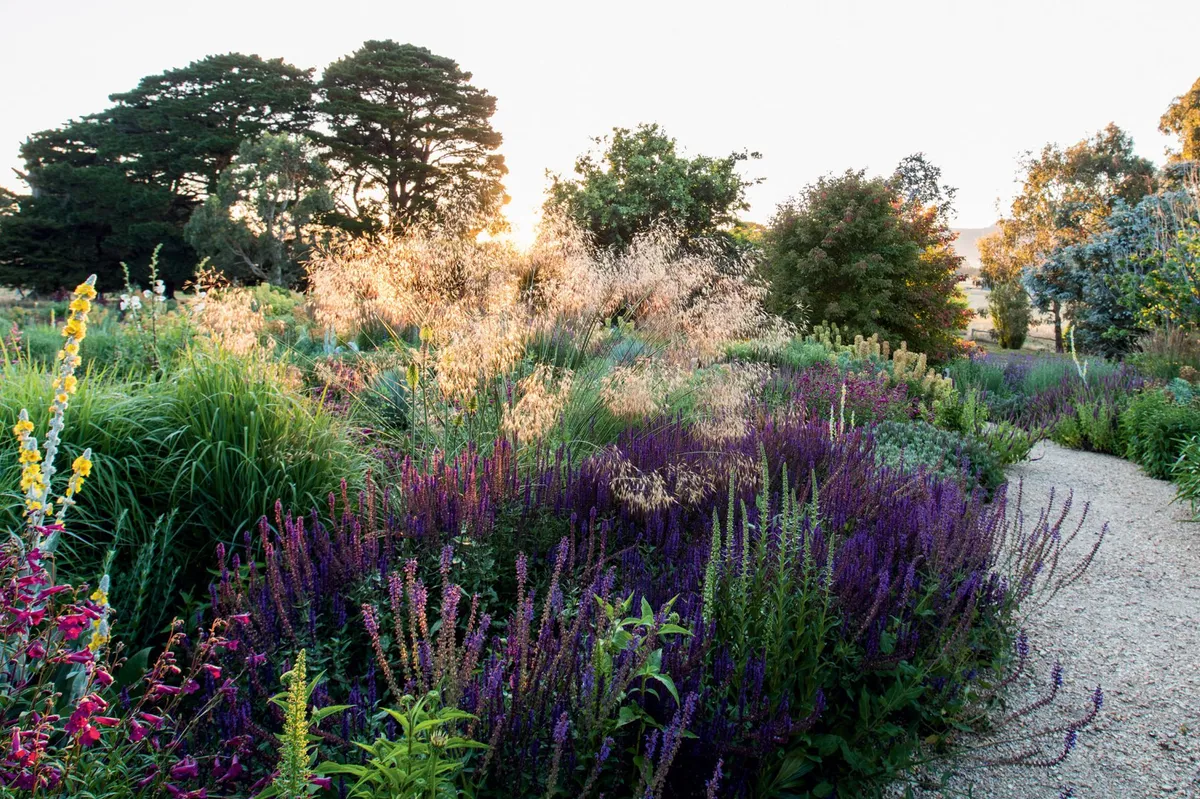
In the Oudolfian-style perennial garden, Michael has created islands of dense, perennial planting to form a waist-high, solid, undulating plateau that is punctured every now and then by plants that rise above it. Here, the beautiful golden heads of Stipa gigantea rise gracefully from the centre of the bed above the richly coloured purple Salvia nemorosa ‘Caradonna’, offset by the fresh green of the switchgrass Panicum virgatum and honey-coloured spires of Digitalis ferruginea.
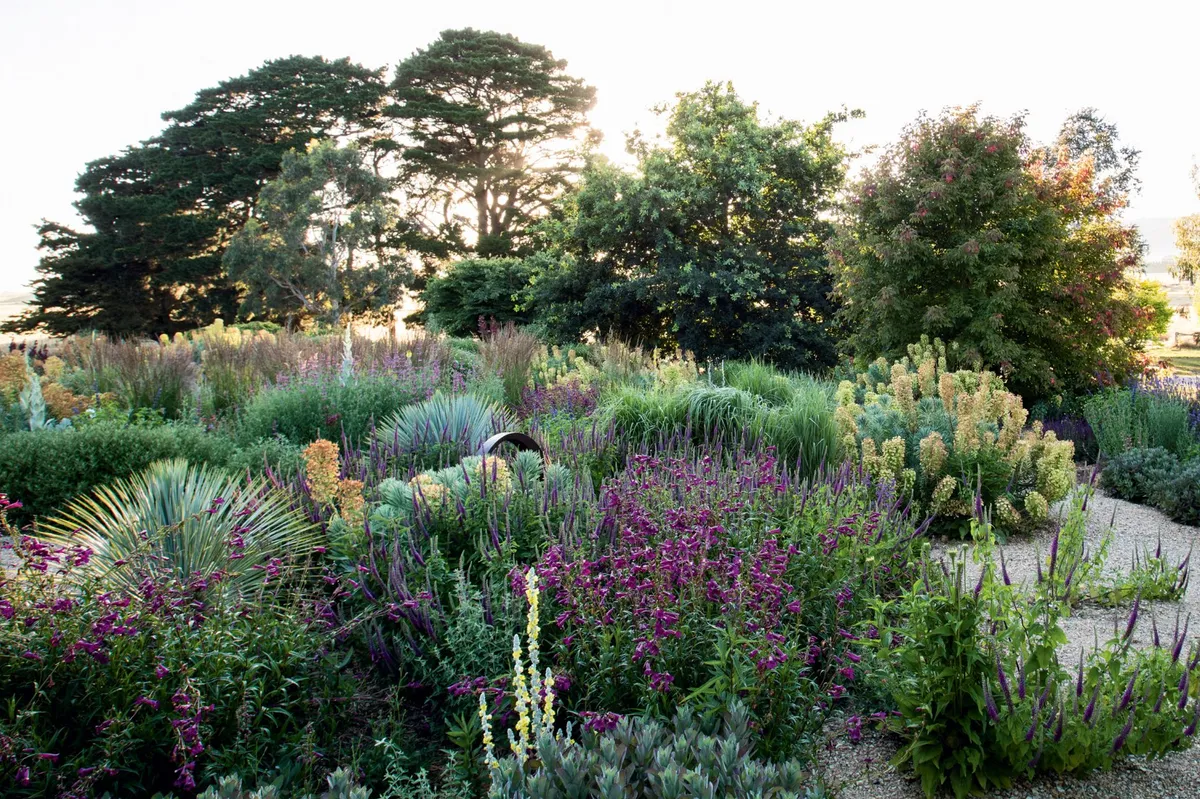
Michael was initially concerned about adding the three Yucca rostrata plants to the perennial garden but has since grown to love their steely solidity in the midst of the soft grasses and perennials. Their glaucous foliage combines subtly with the purple flowers of Penstemon ‘Blackbird’ and their exotic shape works well with the upright flowers of Euphorbia characias subsp. wulfenii.
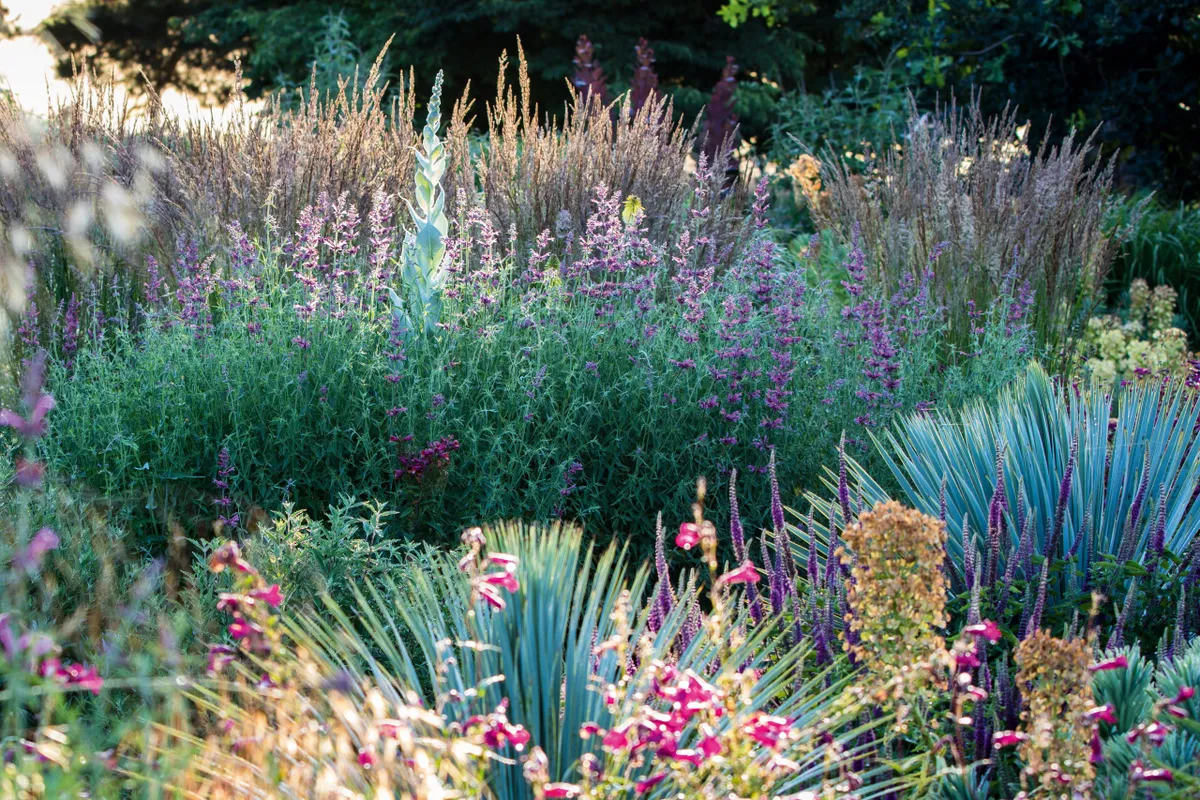
Many of the plants in this border, including Agastache ‘Sweet Lili’ – a fabulously long-flowering, Australian-bred cultivar – and the grass Calamagrostis x acutiflora ‘Karl Foerster’, are emphatically vertical in form. If dense enough in flower, these tall plants can create a horizontal plateau of colour that can be punctured by something much taller, such as this centrally located Verbascum splendidum. In the foreground Penstemon ‘Blackbird’, Euphorbia characias subsp. wulfenii and Teucrium hircanicum add to the vertical theme. The striking, glaucous Yucca rostrata were added to this mix as an afterthought, but Michael now feels they provide a fabulous sense of stability and rigidity among all the other more ephemeral content.
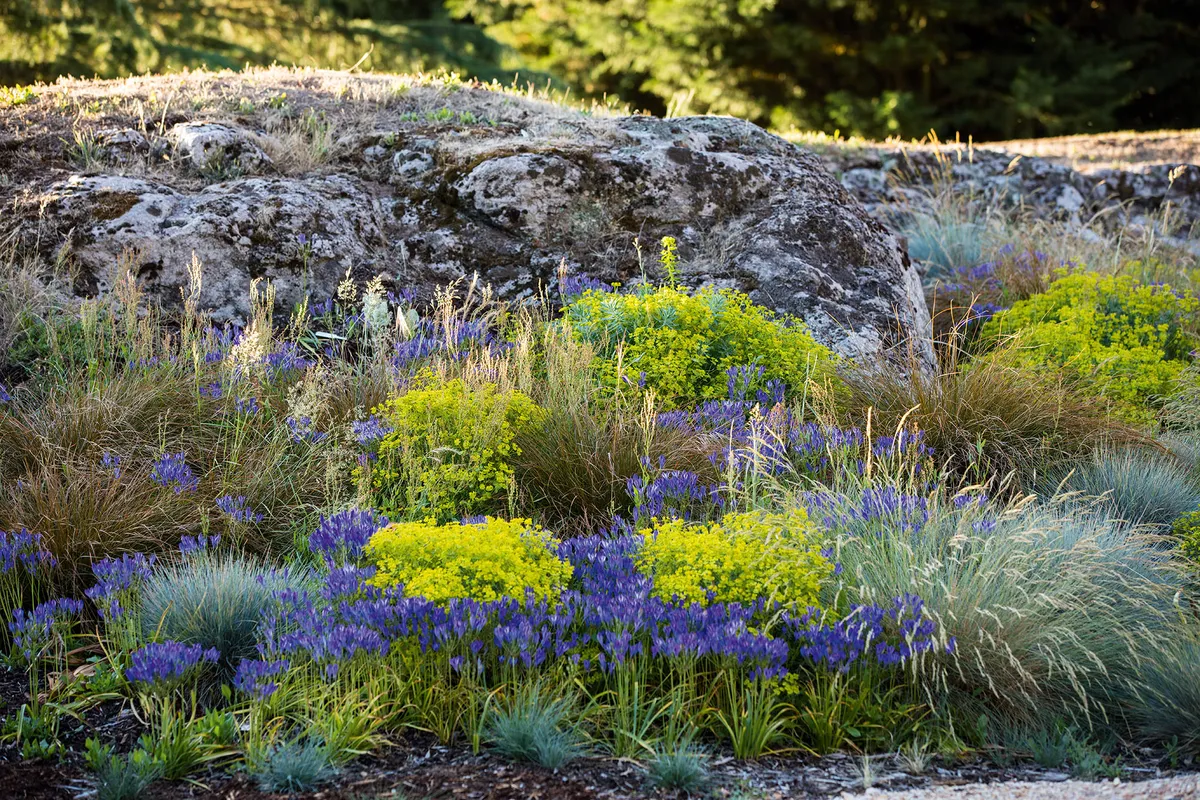
The quarry garden explores an entirely different planting approach to the perennial garden. In this area the ground is almost entirely covered with reasonably ‘self-grooming’ evergreen plants of widely varying texture, such as the blue grass Festuca glauca ‘Elijah Blue’, the long-flowering spurge Euphorbia ‘Copton Ash’ and the orange New Zealand sedge Carex testacea. Seasonal floral colour is then largely provided by a wash of bulbs across the entire space. The large number of each required meant that Michael used only those that were easily and reasonably cheaply available in large numbers, including the summer-flowering cormous perennial Triteleia laxa, which is preceded by species tulips and dwarf irises and then followed in late summer by colchicums.
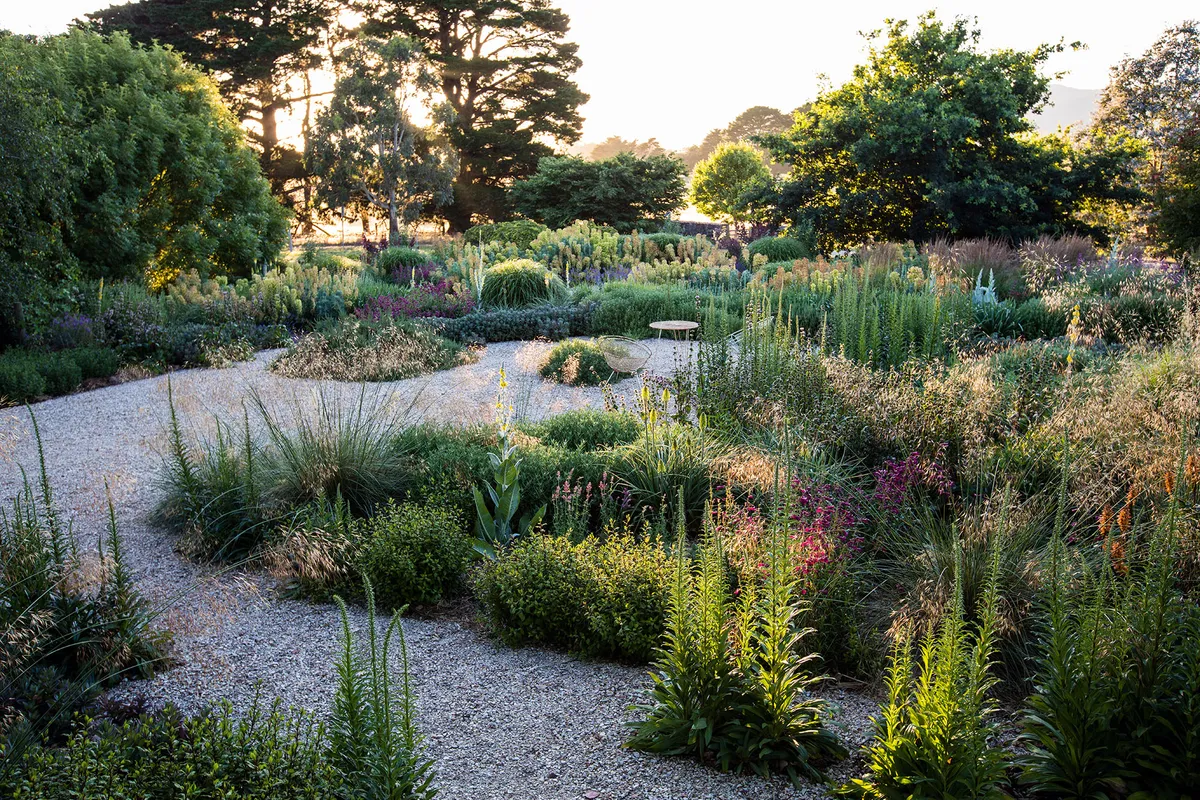
In the perennial garden Michael created streams and pools of gravel that would push well back into the planting, allowing a very diffuse edge of
plants, including what Michael considers the most beautiful of all grasses, Stipa gigantea, alongside soft, late-flowering perennials, such as Ceratostigma plumbaginoides and vertical bursts of summer colour from Verbascum bombyciferum and Kniphofia ‘Lime Glow’. Planting has softened further over time by allowing a degree of managed self-sowing. One of the most enthusiastic self-sowers, and proving almost indestructible in the face of severe drought, is the fabulously vertical Digitalis ferruginea, here bolting to flower along with the rapidly rising flower-spikes of Stipa gigantea.
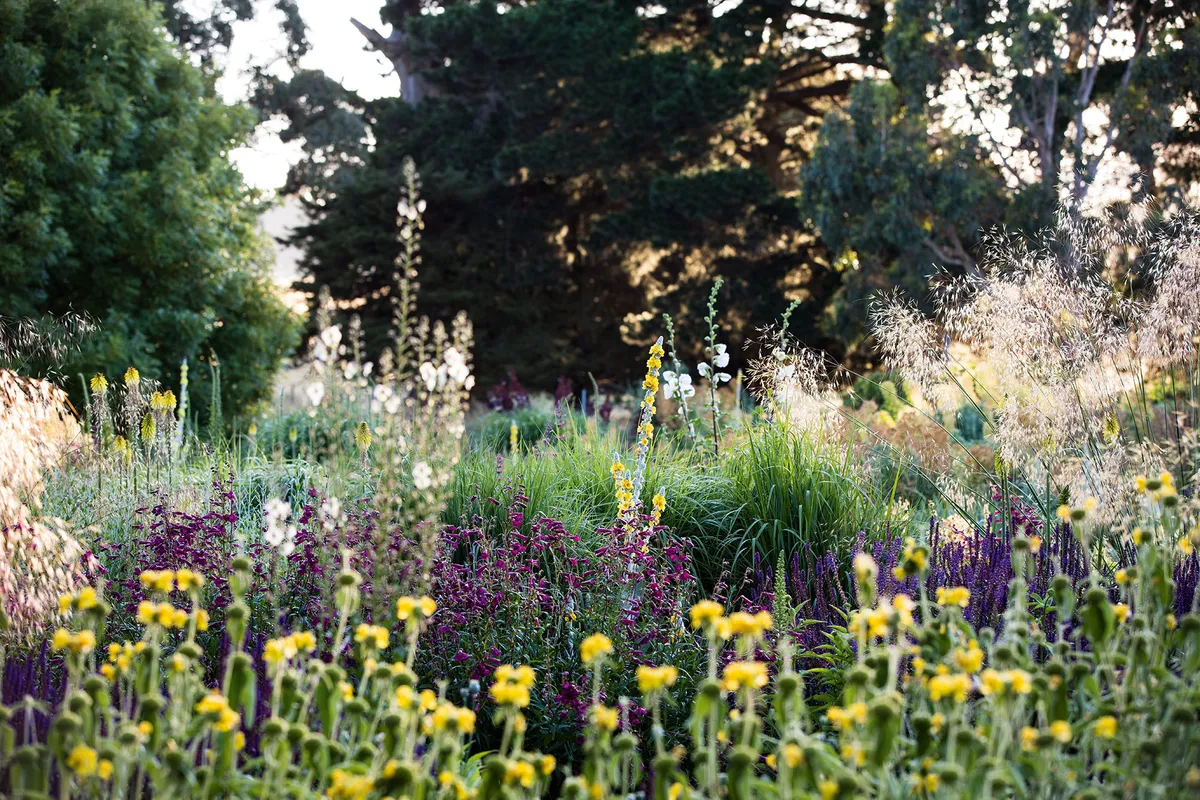
Michael’s original thought was to create a punctured plateau of colour and texture for the perennial garden. In this area the plateau is created by a horizontal bands of Phlomis fruticosa, Penstemon ‘Blackbird’ and Panicum virgatum, punctured by the bolt upright flowers of Kniphofia ‘Lime Glow’, Verbascum chaixii ‘Album’, Verbascum bombyciferum and Alcea rugosa. Michael is convinced that this balance between the density of the undulating plateau and those taller incidents that push through it is critical. As many of these vertical incidental plants self-seed, the balance is in a constant state of flux, which Michael finds delightful and frustrating in equal measures.
Useful information: Find out more about Michael McCoy’s work at thegardenist.com.au